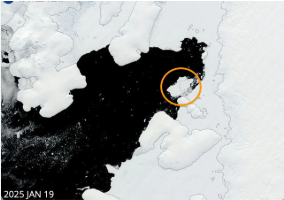On January 13th, the iceberg A-84 broke off the Antarctic ice shelf. With its separation, it revealed 209 miles of seafloor that researchers could not previously access. When they went diving to see what was there, the researchers discovered a thriving ecosystem underneath the ice.
Antarctica has a total of 15 major ice shelves, not including the many smaller ones. The George IV ice shelf is located on the west coast of Antarctica, closest to the tip of South America. A-84 is around 19 miles long and 11 miles wide, the size of Chicago. Since it broke off, it has moved across the west coast of Antarctica, past Smyley and Spaatz Island.
Under the iceberg, it was discovered that a variety of sea creatures inhabited the seafloor. The researchers found fish, giant sponges, sea spiders, octopi and several other sea creatures. Scientists believe that the ecosystem has been alive for several decades, possibly hundreds of years.
Originally, the thick ice blocked any sort of GPS signals from scanning the seafloor, but it was believed that there were several rivers, lakes and estuaries hidden within the ice. Since A-84 broke off, scientists have considered the possibility of several other hidden ecosystems under the ice. They believe that deep water currents had swept nutrients under the iceberg through small gaps between A-84 and the sea floor.
Two rare sea creatures were discovered to be living under the iceberg. Scientists found glass squids as well as colossal squids to be living in the hidden ecosystem. Before then, the only evidence they had of the existence of glass squids was their corpses found in fishing nets or within the stomachs of whales.
Not only did they find a glass squid, they got footage of a baby colossal squid. The last confirmed sighting of this species was in 2007 and before that, the only other sighting was 100 years ago. Because we already don’t know much about the ocean, finding these hidden ecosystems with rare species is important to learning what the ocean’s hiding below, where we can’t see with cameras and submarines.
Since its breakage, A-84 was last spotted going along Antarctica’s west coast on January 31st. It allows scientists to understand the impacts climate change is having on the ice sheets. In general, when icebergs break, it can have multiple detrimental effects on the environment. Sea levels rise when an iceberg is dropped into the ocean, marine life becomes disrupted. It shows that climate change is causing ice sheets to break off or melt. Scientists can also understand how stable the ice shelves are as well as predict how much sea levels will rise in the future.
Scientists continue to study the hidden iceberg ecosystem and what else is waiting to be discovered. There could be more species that we have rarely seen or even new species. As icebergs continue to break off, we’ll be able to learn more about what’s within the ice and what’s hiding underneath it all.






















